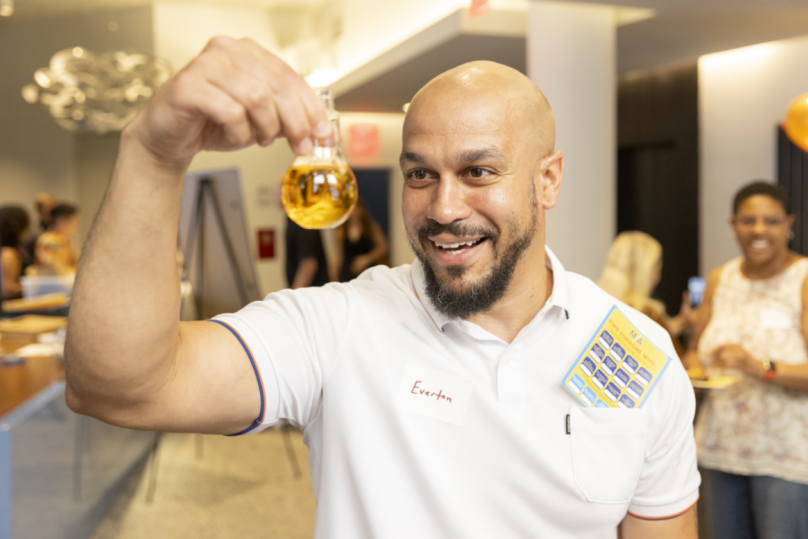
MƒA Master Teacher Everton Henriques teaches complex physics concepts through hands-on applications including radio and wireless technology.
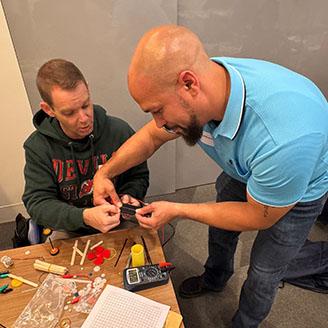
In 2022, Everton Henriques enrolled in an MƒA workshop called “Going Gradeless in Your STEM Classroom.” As a veteran educator, he had questions about the feasibility of going gradeless in his engineering classroom at Staten Island Technical High School. But the workshop gave him the inspiration and confidence — along with some concrete tools — to make changes in the way he was teaching.
Take his unit on gear ratios, the relationship between two gears in a mechanical system. In the past, Henriques tested student understanding of the concept with a traditional written test. Now he and his MƒA colleagues in the workshop brainstormed a number of applied projects through which students could show mastery. Instead of a standard written test, for example, students would “have to do the algebra to create a transmission system with gear ratios that’ll allow us to have a vehicle that can move faster than the motors are capable of moving,” he says.
Henriques took this hands-on activity back to his classroom. “I hammered out a variety of theoretical applications for varied vehicular speed or torque in a written format, and then had students design a single physical system to achieve one of those goals,” he says. “With the additional time, I can now have students design multiple physical systems and showcase their learning in ways that are fun and meaningful for them.”
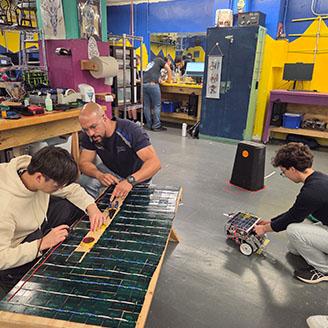
Henriques built on the idea of “gradeless” instruction by creating a new lab for his advanced physics classes on standing wave ratio, or measuring how well a radio signal travels through an antenna system without being reflected back. He assigned them a concrete, exciting task: designing an antenna with the capacity to hit the International Space Station repeater.
The project enabled students to not only master the concept of standing wave ratio, but also practice their soldering techniques through a series of progressively more challenging tasks. “It’s not just a matter of just soldering something — you have to have good solder joints,” Henriques says. “You have to calculate how many elements you need and the spacing of the elements to make this antenna work.”
As with the gear ratio exercise, Henriques immediately saw the impact of this hands-on project on his students. “Students were not afraid to try things and fail, as there was no negative grade to punish them as long as they reevaluated and improved,” he says. “I felt like there was greater ownership over what they were doing.”
In addition to courses like “Going Gradeless,” Henriques credits MƒA’s RoboExpo with inspiring him to experiment with many of the staples he now employs in the classroom, including Tetrix robotics systems and the Arduino open-source hardware and software platform. He went on to co-facilitate RoboExpo himself and shared the results of his gradeless experimentation with his MƒA colleagues.
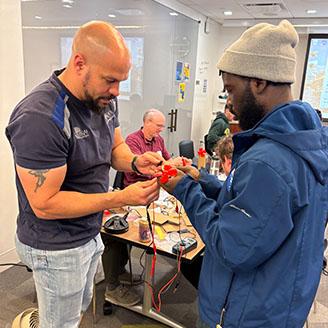
Through RoboExpo and another MƒA course, “High Tech, Low Tech, No-Tech: Project-Based Learning and Design Thinking,” Henriques began exploring wireless radio technology. Also known as “ham” radio, amateur radio is the noncommercial exchange of messages using the radio frequency spectrum. “I realized all these concepts in amateur radio applied directly to physics, and that there are actual applications — like antenna design — that we can get into in the classroom,” Henriques says.
Following this interest, he discovered the American Radio Relay League, the nation’s largest membership association of amateur radio enthusiasts. After earning his first amateur radio license, Henriques used flex funds from MƒA to acquire the electronics necessary to create radio-based challenges in his classroom. “Students were able to design and fabricate projects like antennas, emergency transmitters, remote-controlled vehicles, health sensors and prosthetics,” he says.
The ARRL invited Henriques to attend their Teachers Institute on Wireless Technology, during which he joined fellow educators in learning more about wireless radio and how it could be incorporated into the classroom. After he helped 32 of his students earn their amateur radio licenses, the group named his school an ARRL model school and supplied Henriques and his students with more resources, including radios and other electronics. “They're super into supporting the college endeavors of students, and we're definitely going to be getting scholarships this year for some of our kids,” he says.
“Students were not afraid to try things and fail, as there was no negative grade to punish them as long as they reevaluated and improved."
In January 2025, Henriques organized a four-day training event with ARRL representatives that explained the benefits of radio technology; nine teachers from schools across New York City attended. Henriques and his MƒA colleagues Paul Kehoe and T.J. Smolka are now planning a MƒA Professional Learning Team that will share what they’ve learned about how to expand radio and wireless technology education.
“I feel like MƒA has just thrown so many different stones out there that I've been able to build a wall, and climb that wall,” Henriques says. “My view has gotten much better.”
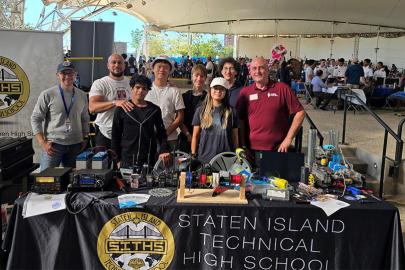
Henriques and his students representing their robotics team and amateur radio club at the Coney Island Maker Faire.